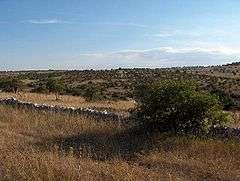Altopiano delle Murge

The Altopiano delle Murge (Italian for "plateau of the Murge") is a karst topographic plateau of rectangular shape in southern Italy. Most of it lies within Puglia and corresponds with the sub-region known as Murgia or Le Murge. The plateau lies mainly in the Metropolitan City of Bari and the province of Barletta-Andria-Trani, but extends into the provinces of Brindisi and Taranto to the south; it also extends westward into the province of Matera in Basilicata. The name stems from the Latin murex, meaning "sharp stone".
Geography
The Murge plateau covers a surface of c. 4,000 km², bordered by the Ofanto river and the Tavoliere delle Puglie on the north, the Adriatic Sea on the northeast, and by the Messapic depression, which separates it from the Salento peninsula, on the south. It is usually divided into Alta Murgia (High Murgia), the highest area, with poorer vegetation, and Bassa Murgia (Lower Murgia), with more fertile land, prevalently cultivated with olives.
The highest elevation of the plateau is the Monte Caccia, at 679 m. The rocks are mostly composed of Cretacic limestone, so that karst landscapes prevail in the area, with doline fields, some large dolines, sinkholes, and caves. The largest dolines may be found near Altamura, Gravina and Molfetta. Near Castellana the most important show cave of Apulia region is located.
The climate is cold in winter, with average temperatures in the 1-6 °C range. In summer, they rise up to 30 °C. Rain, unlike in the arid Salento nearby, is abundant.
Economy
Historically, the Murge have been the seat of transhumance practice in animal husbandry, with cattle being moved to Abruzzo in summer, and southwards during winter. Until the 19th century, agriculture was characterized by large latifundia owned by a few landlords, also due to the relative lack of water.
The modern economic activities include also marble quarries, production of olives, vine, almonds, cherries and mulberries. Animal husbandry include sheep, goats, domestic pigs and bovinae. A local breed of horse, known as Murgese, has been husbanded here since the 16th century.
Tourism and small industries (construction materials, bottling) are also active.
Coordinates: 40°58′34″N 16°24′22″E / 40.97611°N 16.40611°E